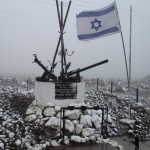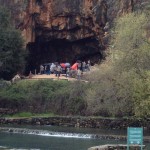
If you followed on Twitter today you know our first stop was the beach on the Sea of Galilee where Jesus appeared to the disciples after His resurrection. (John 21).
From there we headed north for the Golan Heights, near Israel’s border with Syria, but we were turned back by police because the road was iced over.
We changed our plans, turning back south, then to the east and finally to the north. We stopped at Tel Hazor, one of Solomon’s northern most outposts (I Kings 9:15-25; 2 Chronicles 9:25) and Tel Dan, where the 4,000 year-old gates (the oldest in the world) to the city Abraham once entered still stand (Genesis 14:14).
Our next stop was one of the highlights of the day. Caesarea Philippi is in the northern tip of Israel. Here, Jesus told Peter the “Gates of Hades” would not prevail against the Church. (Matthew 16:13-20).
What I never realized until coming here is the Gates of Hades is a real place. When Jesus was here in the first century He would have seen pagan temples in front of the opening to the cave you see in the picture.

The opening to that cave was considered by pagans to be a portal to the underworld, i.e. the Gates of Hades. When Jesus made the statement about the Gates of Hades He was probably pointing at the cave’s opening.
What Jesus was saying was the Paganism of the Roman Empire would not survive the expansion of the kingdom of God. Within 300 years Jesus’ prophecy was fulfilled. By then the Roman Empire had become Christianized, its emperor Constantine converted and paganism disavowed.
After a quick stop at the Mount of Beatitudes (of Sermon-on-the-Mount fame) (Matthew 5), we ended the day at Capernaum, Jesus’ home during His earthly ministry. The Hebrew name of the city, even before Jesus lived here, was and is Kafer Nahum, which means “Village of the Comforter.” Interesting. The house where Jesus and his disciples stayed (Peter’s mother-in-law’s house) is still there, as is the foundation of the synagogue where Jesus preached.
In Capernaum, Arie took us to the bank of the Sea of Galilee (about 50 yards from Peter’s house). This is where Jesus told His disciples to go the other side with Him. On the other side of Sea of Galilee, Jesus healed the demoniac who had been living in the tombs, crying out day and night. (Luke 8:20-37)
From the beach at Capernaum, because of the prevailing winds, at night when the waters are calm you can actually hear people talking on the other bank of Galilee. This gives a whole new dimension to the story of the demoniac. It means Jesus, and probably most in the city, had heard the demoniac crying out night after night, until one day Jesus, moved by compassion, said, “Let’s go to the other side.” It’s another example of how understanding the place gives a fuller understanding of the text.
Until tomorrow. GS
